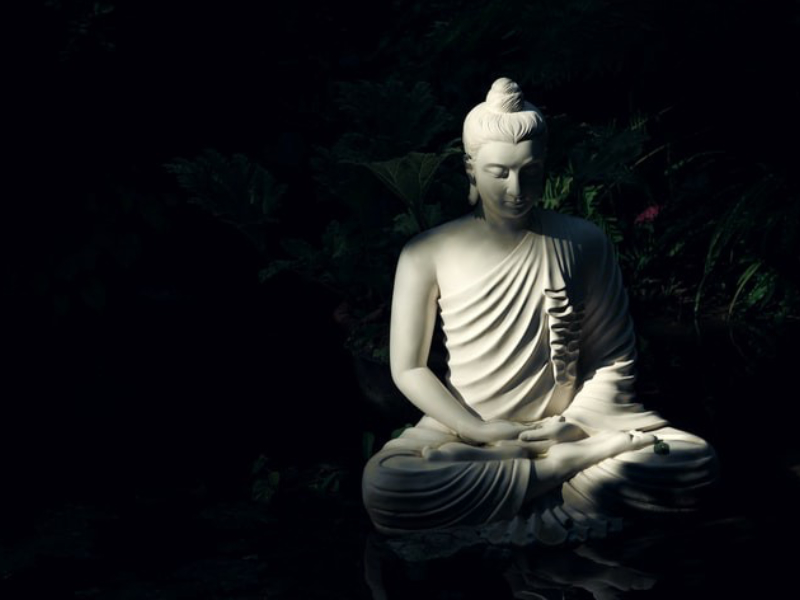Cultivate Reverence
– The Fundamental Mood for Spiritual Growth –

Reverence is a companion — a strong force — in our ascent to the heavens. It continually raises us to higher states of being. Have you ever stood under the Milky Way, sat in a holy place, or been graced by the presence of someone whose wisdom and being you venerate? Have you ever felt awe, humility, or the attitude of devotion toward something much bigger than yourself, which inspired you to seek truth, wisdom, or understanding?
All inner development starts from this basic mood of the soul — the feeling that we have much to learn from the world, from life, love, and experience. To grow, it is important you acquire or cultivate this mood or attitude to seek in all things, in all experiences, that which arouses awe, admiration, and respect.
The Practice – Cultivating Reverence
This practice — this cultivation of reverence — should not remain simply an outer rule of life but must take hold of the innermost part of your soul. It is not enough to show this respect outwardly in your relations with others and with the world. You must hold this respect and veneration in and toward your thoughts.
I invite you to bring this feeling of reverence, devotion, and awe into your inner life — to your thoughts and feelings. Guard against all disrespectful, disparaging, and criticizing thoughts. Try to practice reverence in your thinking at all times and in all places.
Every time you become aware of derogatory, judgmental, and critical thoughts within yourself, note it and then don’t rush away. But rather pay attention to what experience is like the moment you catch yourself in that thought. Pay attention to where the thought goes and also the quality of experience once it’s gone. And then contemplate your admiration, respect, and reverence for the world, for life, love, and experience.
See for yourself, but I think you’ll find that this will awaken a life you didn’t know you had. Filling your consciousness in this way will open your spiritual eyes. You will begin to see things you could not see before. You’ll begin to realize that you’ve only been looking at part of the world around you. And you will begin to see yourself and others in a much fuller and vivid light.
To strengthen this new force, this new faculty, to be able to see the world more deeply, more intimately, I have provided
below a few exercises by Rudolph Steiner, Meister Eckhart, and others to cultivate this general mood.
Before you explore them, however, let me first say a few more general remarks. It is extremely important that you orient yourself from the inside, from your soul, and not the outer world. Pay attention to your inner life. A rich inner life should orient you in your responses to impressions from the outer world. A person rich in feeling and deep of soul who passes through a beautiful landscape will have a very different experience from one whose inner life is poor in feeling.
Inner experience is the key to the outer world’s beauty. To develop a meaningful relationship to the outer world, you first have to learn to work with your own feelings and ideas.
The world around us is filled everywhere with god’s beauty, but we have to experience the divine in ourselves before we can find it in our surroundings. And that’s why we practice.
(For additional exercises, see Rudolf Steiner, Start Now!)
Reverence Exercises
1. Gaining a Higher Perspective: Pick an activity to do every day which lasts about five minutes. And, while you perform this activity, put away all self-concern — allow your joys, sorrows, worries, experiences, and actions to pass before your soul. And, instead, look at everything you are doing and experiencing from a higher point of view — judge your own experiences and actions as if they belonged to someone else, someone truly noble and wise.
2. Cosmic Sounds: Direct your attention to the world of sounds, and distinguish — discover and demarcate the walls, the borders — produced by:
(a) Inanimate — or material — objects (motors, falling objects, bells, rings, and musical instruments) and
(b) Sounds that come from living beings, whether animals or people.
In the beginning of this practice, note with each sound the inward feeling associated with the sound (pleasant, unpleasant, or neutral). But as you progress, with living things, begin to turn your focus not only to how it evokes an inner association in yourself but also how it reveals the animal’s inner experience — its pleasure or pain. Let your goal be to come to feel and relate to the whole of Life in this way.
3. Mineral, Plant, & Animal Realms: For 2–10 minutes, direct your full attention, at the exclusion of all else, to the comparisons between a stone and an animal. Allow the thoughts you form in making these comparisons to pass through your soul accompanied by living feelings — pay attention to the feelings associated with each thought.
Think to yourself, ‘The stone and animal each have form. But the stone stays peacefully in place, while the animal moves. The animal has instincts (or desires) that move it through the world. Stones, on the other hand, are not shaped by a force without desires.“
As your concentration and practice develops, increasingly become aware of the two very different feelings that come to life in your soul. At first, you probably won’t notice the feelings much at all. But as you progress a little, the feelings will start to last about as long as the observation lasts. Later, they will continue to work in you for some time after the practice is over. And, eventually, if you continue to practice, they will become something that remains in your soul — a new faculty of sorts.
At a later time, whenever it feels appropriate to you, add to this exercise the contemplation of a plant.
4. The Power of Seeds: Place a seed in front of you and establish what you are seeing with your senses — the form, color, texture, smell, and other properties.
Then, ponder the thought, “This seed, if planted, will grow into a complex plant.” Visualize the plant. Make it come alive in you. Build it up in imagination.
Next, think to yourself, “What I am now visualizing in my imagination will, in reality, be drawn up by the forces of the earth and sun out of this little seed. But if this were an artificial seed, an artificial copy so perfect that my eyes could not distinguish it from a real seed, then no forces of earth and light could draw forth such a plant from it.”
Finally, if you can clearly form this thought and bring it to life within you, next form the thought and feeling: “Already concealed within this seed — as the force of the whole plant — is what will later grow out of it. An artificial copy of the seed has no such force. Yet, to my eyes, both seeds look the same. Therefore, the real seed contains something invisible that is absent in the copy.“
Now let your thoughts and feelings focus on this invisible reality. Imagine that this invisible force or reality will, in time, change into a visible plant whose color and form you will be able to see. Hold the thought, “The invisible will become visible. If I were unable to think, then what later becomes visible could not announce itself to me now.“
Note that it’s important to emphasize that whatever you think, you must also feel with intensity.
5. Birth, Growth, Decay, Death: Place a plant in front of you and immerse yourself in the thought, “There will come a time when this plant withers and decays. Everything I see now will no longer exist. But the plant will have produced seeds, and these will become new plants.”
Next, consider that you will have become aware of something you cannot see that is hidden in what you can see.
Finally, inspire in yourself the thought, “Soon, the plant form with all its colors will no longer be there. But knowing that the plant produces seeds teaches me that it will not disappear into nothingness. I cannot see what preserves the plant from disappearing, anymore than I could see the future plant in the seed. It follows, then, that something else is in the plant that I cannot see with my eyes. If I let this thought live in me, and if the appropriate feelings unite with it, then after a while, a new force will grow in my soul and become a new perception.”
6. Listening to Humans: While listening to people, learn to silence your entire inner being and, instead, sink entirely into the person who is speaking, and empty from yourself your own biases and judgments.
Often, when someone gives an opinion and another listens, agreement or disagreement stirs immediately within the listener. And the listener often feels compelled to express his own opinion at once, especially if he disagrees. This obscures us from really understanding the person speaking, and therefore prevents us from ascending to a higher plane — from learning more about ourself and the world around us.
While listening, then, learn to silence this automatic reactivity — to silence any agreement or disagreement with the opinions you hear. Merge yourself entirely with the human across from you. And if disagreement or an impulse to respond remains after letting it sit, you may at a later time respond to the speaker with kindness, compassion, and understanding.
7. Selfless Wishings: Find stillness, an inner calm, and then visualize a person you have seen or who you know is wishing for something. Direct all your awareness to this desire, to this wish. It is best to recall the moment when the desire was strongest, and this person didn’t know whether he or she would satisfy the desire.
Then, surrender to this picture — dedicate yourself entirely to what you can observe in your memory. Try your best to ignore everything else going on around you. And, above all, pay close attention to any feeling awakened in your soul by the mental image you have formed. Then, allow this feeling to arise within you, like a cloud on an otherwise empty horizon.
8. The Neutral Judge: Reflect on a single encounter you had recently and judge this encounter from a neutral standpoint — face yourself with the inner tranquility of a judge, completely independent of the circumstances and conditions of your particular life.
If you achieve this, your experiences will reveal themselves in a new light. As long as you are still woven into your experiences and stand within them, you will remain just as attached to the non-essential, the transitory or fleeting, as you are to the essential. But once you attain the inner peace of the overview, the non-essential will separate itself from the essential.
Sorrow and joy, every thought, and every decision will look different when you face yourself in this way. As you progress in this direction, you will increasingly be able to control the way impressions from the outer world affect you.
You will, for example, be able to take the sting out of hurtful comments before they bleed into your inner being. Or, as another example, when you realize from the place of a neutral judge that impatience, say, is futile, then, whenever you feel impatience creeping in, the time you may have wasted in expressions of this feeling of impatience can instead be filled with useful observations or meditative practices while you wait.
More Articles
“The Art of Bare Attention”
Today we’re going to talk about the ancient Buddhist practice vipassana, or insight meditation. Now, just to be clear, this is an entirely secular practice. It doesn’t require you to adopt any dogmatic beliefs…
“The Faceless Seer”
How do you hold your love? Do you hold her from stillness, with nowhere to go, with nothing to do? How do you hold your love? Do you hold her with acceptance, with open hands and arms, with unabashed…
“Everything Changes”
It’s no secret everything changes. Your experience this morning isn’t your experience now. Yet how many of us act like we really understand this? How often do we grasp onto the illusion of things…
“The Divine Connection”
How do you hold your love? Do you hold her from stillness, with nowhere to go, with nothing to do? How do you hold your love? Do you hold her with acceptance, with open hands and arms, with unabashed…






